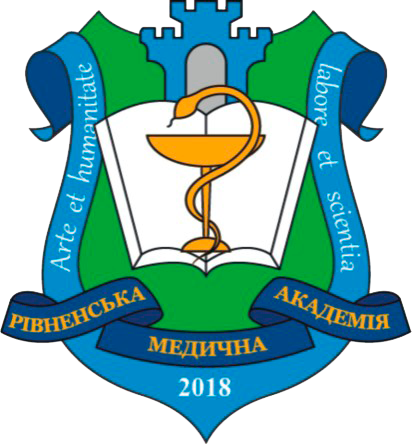PRINCIPLES OF HYDROKINESIOTHERAPY AFTER PLASTIC AND RECONSTRUCTIVE RESTORATION OF THE ANTERIOR CRUCIATE LIGAMENT OF THE KNEE JOINT
DOI:
https://doi.org/10.32782/health-2024.4.15Keywords:
cruciate ligaments, hydrokinesitherapy, physical therapyAbstract
The aim of the study is to evaluate the effectiveness of the complex application of physical therapy after reconstructive surgery to replace the anterior cruciate ligaments of the knee joint.Materials and methods. The experiment was conducted on the basis of the Regional Centre for Arthrology and Rehabilitation of Rivne City Hospital. It involved 26 patients after plastic-reconstructive repair of completely torn anterior cruciate ligaments of the knee joint. All patients were divided by random selection into two groups, the main andcontrol groups – 13 people in each. The key to the equivalence of the functional state of patients in both groups in the postoperative period was testing of the restored joints on a 5-point pain scale (Wong-Baker scale) and on a 5-point scale of strength of the thigh and lower leg muscles of the operated limb (Lovett scale). The condition of the operated limb sat the beginning of the experiment was approximately the same.At the Centre for Arthrology and Rehabilitation, patients in the control andintervention groups received identical medication and rehabilitation treatment, plus thepatients in the intervention group additionally, three times a week, were engaged inhydrokinesitherapy for 30 minutes, according to our experimental method.Results. A month after the start of the experiment, we conducted a scheduled control test, according to the scales described above, and obtained the following results: 1) in 8 patients out of 13, the intensity of pain in patients of the main group decreased, compared to patients of the control group (4 out of 13), i.e. by 30%; 2) the tone and strength of the thigh and posterior tibial muscles of the operated limbs in patients of the main group increased in 11 patients out of 13, compared to patients of the control group (8 out of 13), i.e. by 23%.Conclusions. The use of hydrokinesitherapy, after reconstruction of the anteriorcruciate ligaments of the knee joint, in combination with drug therapy and strengthening exercises in the air, significantly accelerates the recovery of the operated knee joint.
References
Bachmaier S., DiFelice G.S., Sonnery-Cottet B. та ін. Лікування гострих розривів проксимальної передньої хрестоподібної зв’язки – частина 2 : роль внутрішньої фіксації у формуванні розриву та стабілізації методів відновлення. Orthop J Sports Med. 2020. № 8.
Calvert N.D., Smith A., Ackland T., Kuster M.S., Ebert J. Kneeling difficulty is common following anterior cruciate ligament reconstruction with hamstring autograft and correlates with outcome measures. Arch Orthop Trauma Surg. 2020; 140 : 913–921.
Heusdens C.H.W., Hopper G.P., Dossche L., Roelant E., Mackay G.M. Anterior cruciate ligament repair with independent suture tape reinforcement : a case series with 2-year follow-up. Knee Surg Sports TraumatolArthrosc. 2019 ; 27 : 60–67.
Widner M., Dunleavy M., Lynch S. Outcomes following ACL reconstruction based on graft type: are all grafts equivalent? Curr Rev Musculoskelet Med. 2019 ; 12 : 460–465.
Leong N.L., Kator J.L., Clemens T.L., James A., Enamoto-Iwamoto M., Jiang J. Tendon and ligament healing and current approaches to tendon and ligament regeneration. J Orthop Res.2020 ; 38 : 7–12.
Meierbachtol A., Obermeier M., Yungtum W. et al. Injury-related fears during the return-to-sport phase of ACL reconstruction rehabilitation. Orthop J Sports Med. 2020 ; 8 : 2325967120909385.
Murray M.M., Fleming B.C., Badger G.J. et al. Bridge-enhanced anterior cruciate ligament repair is not inferior to autograft anterior cruciate ligament reconstruction at 2 years : results of a prospective randomized clinical trial. Am J Sports Med. 2020 ; 48 : 1305–1315.
Anderson S.R., Youssefzadeh K.A., Limpisvasti O. Anterior cruciate ligament reconstruction with suture tape augmentation: a surgical technique. Arthrosc Tech. 2019 ; 8 : e1579–e1582.
Buckthorpe M., Della Villa F., Della Villa S. et al. On-field Rehabilitation Part 1: 4 Pillars of High-Quality On-field Rehabilitation Are Restoring Movement Quality, Physical Conditioning, Restoring Sport-Specific Skills, and Progressively Developing Chronic Training Load. J Orthop Sports PhysTher2019 ; 49 : 565–9.
Ghaderi M., Letafatkar A., Thomas A.C. et al. Effects of a neuromuscular training program using external focus attention cues in male athletes with anterior cruciate ligament reconstruction : a randomized clinical trial. BMC Sports Sci Med Rehabil2021 ; 13 : 49.
Peultier-Celli L., Mainard D., Wein F. et al. Comparisonofan Innovative Rehabilitation, Combining Reduced Conventional Rehabilitation with Balneotherapy, an da Convention-al Rehabilitation after Anterior Cruciate Ligament Reconstruction in Athletes. Front Surg. 2017 ; 4 : 61.
Scott J., Wozencroft A., Nocera V., Webb K., Anderson J. Aquatic Therapy Interventions and Disability: A recreational therapy perspective. Int J Aquat Res Educ.2020 ; 12(3) : 5.
Buckthorpe M., Pirotti E., Villa F.D. Benefits and use of aquatic therapy during rehabilitation after ACL reconstruction: A clinical commentary. Int J Sports Phys Ther.2019 ; 14(6) : 978–993.
Hajouj E., Hadian M.R., Mir S.M., Talebian S., Ghazi S. Effects of innovative aquatic proprioceptive training on knee proprioception in athletes with anterior cruciate ligament reconstruction: A randomized controlled trial. Arch Bone Jt Surg.2021 ; 9(5) : 519–526.





